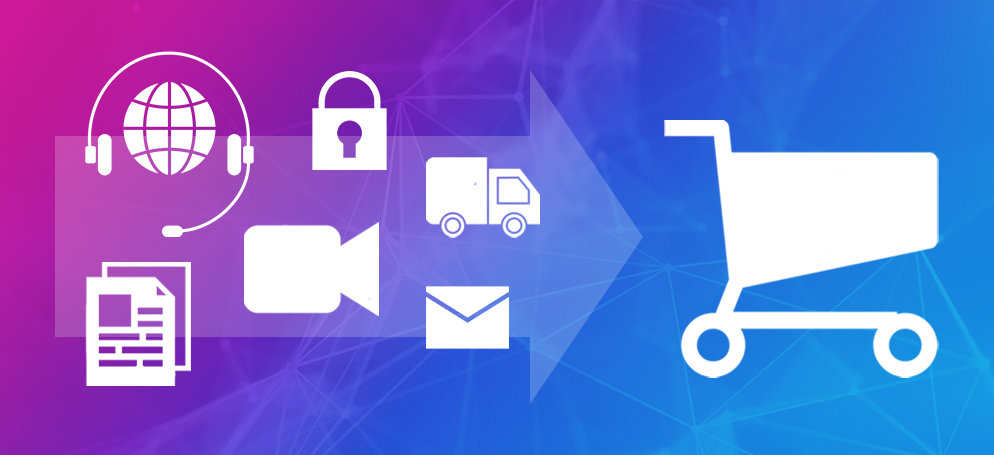
How Covid has changed the B2B buying journey
In the last year, the large-scale shift to remote working and the moratorium on events and face-to-face networking has had a significant impact on the B2B path to purchase. Here, we explain what B2B marketers need to know.
These changes look set to endure
According to McKinsey, as of October 2020, 90% of B2B decision-makers expect the remote and digital model to endure for the long-term, and 3 in 4 believe the new model is as effective or more so than before Covid (for both existing customers and prospects). Moreover, only 20-30% of B2B buyers want to interact with sales reps in person even in their ideal post Covid scenario.
Purchase drivers have evolved
Traditionally, value, ease-of-use and efficiency are all important B2B purchase drivers – especially towards the end of the purchase funnel. However, a Global Web Index survey of B2B tech buyers, conducted at the end of 2020, showed that the order of priorities amongst decision-makers had shifted somewhat:
• Price was no longer amongst the top 5 drivers
• Instead, technical support was valued – a reflection of the number of businesses now working in the cloud
• Given the spike in phishing attacks targeting remote workers, decision-makers have grown more aware of cybersecurity
Generally, the pandemic has seen a flight to safety across categories. The events of the last year are likely to have affected your customers’ sense of priorities. Keeping an eye on audience intent – and how this might vary by market – is essential.
This means you need to re-evaluate the entire buying journey
Even before the pandemic, B2B decision-makers were reviewing more material before making a decision – driven by two factors:
• The sheer volume of content available
• The increased pressure to deliver ROI – meaning decision-makers spend more time carrying out due diligence before deciding
Given shifting audience intent, it is important to take a critical look at the buying journey through fresh eyes. For example:
• Is your content still fit for purpose? Do you have the right content at each stage of the buying journey? Is it properly tailored to the needs of each market?
• In the absence of face-to-face selling, how do you retain a human touch? For example, are you making good use of live chat and video?
• Is there scope to use artificial intelligence and machine learning to predict what a customer needs, often from vast inventories of business products – helping to guide them through a B2B site accurately and quickly?
Your sales team need to be given the best tools
Before the pandemic, B2B sales often took place via face-to-face meetings and events. Cold-calling prospects was the norm. Very often, payments were still made using paper purchase orders and cheques.
In the last year, with in-person engagements curtailed and people working at home (and therefore less easy for cold callers to reach), the role of sales reps has been disrupted. The rise of customers buying online through self-serve digital channels raises questions:
• Do you still have the ability to engage prospects digitally how and when they want?
• Are you offering an integrated experience which allows prospects to move seamlessly from one channel to another?
• Do your sales teams have access to critical, always up-to-date local market- and customer-specific insights? Do they have the tools and insights they need to deliver value as they engage prospects?
In answering these questions, the challenge for B2B marketers is to:
• Pinpoint opportunities in the sales process to blend digital and virtual interactions to cultivate personal connections with your customers
• Train sales teams on the new digital and virtual deal execution methods and tools
• Continue to be highly communicative via digital channels and use automation to reduce friction in sales communication
• Identify opportunities for personalisation – for example, personalised emails to prospects at critical points of the purchase journey
• Create a single source of truth – i.e. integrate your marketing, sales and service platforms to get a single source of truth for your campaigns, leads, customers and partners
Data driven insights via machine learning and artificial intelligence enable businesses to achieve a consistent view of buyers and their shifting needs and preferences. That data could be a combination of intent data and transaction history, data on what peers have purchased, seasonality, commodity prices and more. These insights enable businesses to tailor offers and messages to different audience segments.
A key issue is pricing
Unlike B2C, B2B pricing is usually not shown online. This is because different clients in different sectors and markets can pay different prices for the same product, depending on their order – e.g. discounts for bulk or repeat purchases. Pre-Covid, pricing could be negotiated face-to-face or over the phone by sales reps. Post-Covid, with the shift to online, some B2B customers may wish to see pricing transparency on websites.
A solution for B2B companies may be to create a portal for prospects or existing clients, who can log in to see tailored sets of products and prices.
After a year of layoffs, budget cuts, hiring freezes and salary reductions, the economic uncertainty ahead means that value will be a key consideration for many brands. Thinking carefully about how you communicate value throughout the entire digital experience will be critical.
Decision makers are getting younger
Not related to the pandemic – but B2B buyers are getting younger. According to B2B International, millennials will make up 44% of the workforce by 2025. A study by Global Web Index showed that 74% of millennials are involved in making buying decisions at B2B companies. They are already driving a digital approach to B2B selling – and three things stand out about them:
• They are digital natives who grew up online. They are used to the speed and ease of Amazon and eBay – on-demand, easy-to-use consumer platforms which have radically shaped their expectations in business. If tech platforms don’t keep up, they are quickly abandoned.
• They were raised on apps like Uber and Airbnb, so they expect the same level of UX and ease of use in their professional solutions. They expect personalisation, convenience, flexibility, and digital-first professional interactions – preferably via less formal communication mediums, such as messaging, video, and social media.
• They are purpose-minded and concerned about the environment, inclusivity and gender equality. They expect brands and employers to reflect their values, and have started to expect B2B vendors to do the same. This shift is likely to have been accelerated by Covid-19 and the international social justice movements of the last year.
In response to these trends, disruptive B2B brands like Stripe, Mailchimp, Basecamp, Shopify and Slack have started to emulate influential consumer brands with pithy language, convenience, attractive design and UX.
B2C has shaped B2B expectations
It’s not just millennials: social media and the rise of self-led product research in the B2C market are influencing expectations across the board of what B2B e-commerce websites should look and feel like. This means:
• Content-rich, personalised, mobile-friendly websites with tailored homepages
• Increasing use of video (e.g. product demos and customer testimonials) and live chat
• Increasing use of voice search
• Augmented and virtual reality – to help customers visualise products before they buy
• Prompt delivery speeds
• Use of Facebook and Instagram to generate good quality leads
. . .
Oban can help
The dramatic increase in digital adoption over the last year represents a significant opportunity for B2B organisations. The shift to online can help businesses lower their cost per visit, extend their reach and significantly improve sales effectiveness. But while the opportunity is significant, so is the pressure to capitalise on it. To find out how Oban can help, please get in touch.

Suzie Oakford | Commercial Director
Oban International is the digital marketing agency specialising in international expansion. Our LIME (Local In-Market Expert) Network provides up to date cultural input and insights from over 80 markets around the world, helping clients realise the best marketing opportunities and avoid the costliest mistakes.